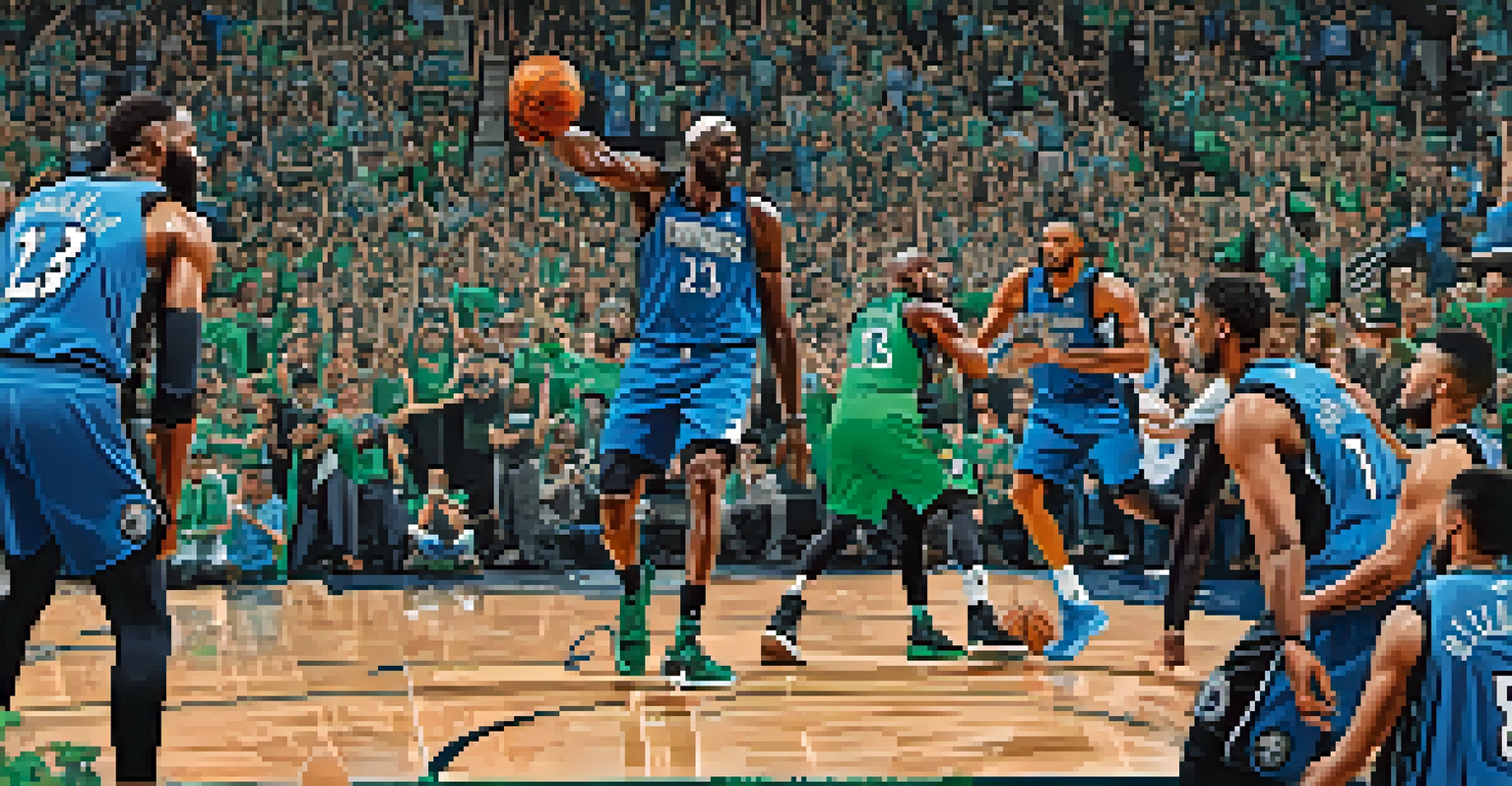Timberwolves Overview: From Origins to Current Season

The Birth of the Timberwolves: A New Franchise Emerges
The Minnesota Timberwolves were established as an NBA franchise in 1989, bringing professional basketball to Minneapolis. The team was founded by businessman Harvey Ratner, who was eager to create a basketball culture in the state. Their name reflects the region's rich natural heritage, as Minnesota is known for its dense forests and abundant wildlife, particularly wolves.
The strength of the team is each individual member. The strength of each member is the team.
In their inaugural season, the Timberwolves faced the typical challenges of a new team, including building a roster and establishing a fan base. Despite a tough start, the franchise showed promise, setting the stage for future developments. The team’s first head coach, Bill Musselman, helped lay the groundwork for the organization's identity and competitive spirit.
The early years were a mix of struggles and growth, but this period was crucial for the Timberwolves as they began to carve out their place in the NBA. Fans remained optimistic, and the community rallied behind their new team, fostering a sense of belonging that continues today.
The Kevin Garnett Era: Rise to Prominence
The arrival of Kevin Garnett in 1995 marked a turning point for the Timberwolves. Drafted fifth overall, Garnett quickly became the face of the franchise, showcasing his extraordinary skills and versatility on the court. His work ethic and determination inspired both teammates and fans alike, leading to a significant shift in the team's performance.

Under Garnett's leadership, the Timberwolves made their first playoff appearance in 1997, igniting excitement and hope within the fan base. This era saw the team develop a competitive roster around Garnett, including key players like Sam Cassell and Latrell Sprewell. The combination of talent led to the franchise's first division title in 2004 and a memorable run in the playoffs.
Timberwolves' Origins and Growth
The Minnesota Timberwolves were established in 1989, facing initial challenges but gradually building a dedicated fan base and team identity.
Though the Timberwolves ultimately fell short of a championship during Garnett's tenure, his impact on the franchise is undeniable. He remains a beloved figure in Minnesota sports history, and his legacy continues to resonate with fans and players alike.
Post-Garnett Challenges: A Period of Transition
After Kevin Garnett's departure to the Boston Celtics in 2007, the Timberwolves faced a challenging transition period. The team struggled to find its footing, going through several coaching changes and roster overhauls. This era tested the loyalty of Timberwolves fans, who yearned for a return to the playoffs.
Sports can create hope where once there was only despair.
Despite the difficulties, the Timberwolves began to rebuild through the draft, selecting promising players like Al Jefferson and later, Derrick Williams. The team aimed to cultivate young talent while navigating the complexities of the NBA landscape. However, inconsistencies in performance hindered their progress, leading to a prolonged playoff drought.
This period was marked by a sense of uncertainty for the franchise, but it also laid the groundwork for future success. The struggles reinforced the importance of perseverance and community support, as fans held onto hope for brighter days ahead.
The Rise of Karl-Anthony Towns: A Fresh Start
In 2015, the Timberwolves drafted Karl-Anthony Towns first overall, signaling a new chapter for the franchise. Towns quickly established himself as a dominant force in the league, showcasing his unique blend of size, skill, and basketball IQ. His arrival reinvigorated the fan base and sparked excitement about the team's future.
Alongside Towns, the Timberwolves acquired players like Andrew Wiggins and later, Jimmy Butler, aiming to build a competitive roster. This trio created a sense of optimism as they navigated the challenges of the NBA. The team made significant strides, culminating in a playoff berth in 2018, the first since Garnett's departure.
Kevin Garnett's Impact on Success
Kevin Garnett's arrival in 1995 transformed the franchise, leading to their first playoff appearance and establishing a competitive legacy.
Although the playoff run was short-lived, it was a pivotal moment for the franchise, demonstrating the potential of their young core. Fans felt a renewed sense of hope as the Timberwolves began to establish their identity in the league.
Coaching Changes and Strategic Shifts
The Timberwolves have experienced a series of coaching changes in recent years, each bringing a different philosophy to the team. After the departure of Tom Thibodeau, the franchise hired Ryan Saunders, aiming to create a more player-friendly environment. This shift in coaching style was intended to foster development and camaraderie among players.
However, the transition did not yield immediate results, leading to further changes in leadership. The hiring of Chris Finch in 2021 marked a new approach, focusing on offensive creativity and maximizing player strengths. Under Finch's guidance, the Timberwolves sought to emphasize ball movement and spacing, aiming for a more dynamic style of play.
These coaching changes have been instrumental in shaping the team's identity, demonstrating the importance of adaptability in professional sports. As the Timberwolves continue to evolve, the impact of their coaching decisions will play a crucial role in their success.
Current Season: Building on Momentum
As the current season unfolds, the Timberwolves are looking to build on the momentum generated in previous years. With Karl-Anthony Towns and Anthony Edwards leading the charge, the team aims to compete for a playoff spot. Their chemistry on the court has been evident, and fans are excited about the potential for success.
The Timberwolves have made strategic moves during the offseason, including key acquisitions that strengthen their roster. This commitment to improvement reflects the organization's desire to create a winning culture in Minnesota. As they navigate the challenges of the season, maintaining consistency will be crucial for their aspirations.
Community Engagement Beyond Basketball
The Timberwolves actively contribute to their community through outreach programs, emphasizing their role as a positive influence beyond the court.
Fans are rallying behind the team, hoping for a return to playoff contention. The spirit of optimism and support within the Minnesota community remains a driving force, as the Timberwolves strive to establish themselves as a competitive franchise in the NBA.
Community Impact: Timberwolves Beyond Basketball
The Minnesota Timberwolves are not just a basketball team; they play a significant role in the local community. Through various outreach programs and initiatives, the franchise actively engages with fans and residents, emphasizing the importance of social responsibility. This commitment to community service has fostered a strong bond between the team and its supporters.
Programs such as youth basketball clinics and educational workshops reflect the Timberwolves' dedication to inspiring the next generation. By promoting physical activity and teamwork, the team encourages young athletes to pursue their dreams both on and off the court. This engagement goes beyond sports, highlighting the franchise's role as a positive influence in Minnesota.

As the Timberwolves continue to grow, their impact on the community remains a cornerstone of their identity. Fans appreciate the team's efforts to give back, reinforcing the idea that sports can be a powerful catalyst for change.